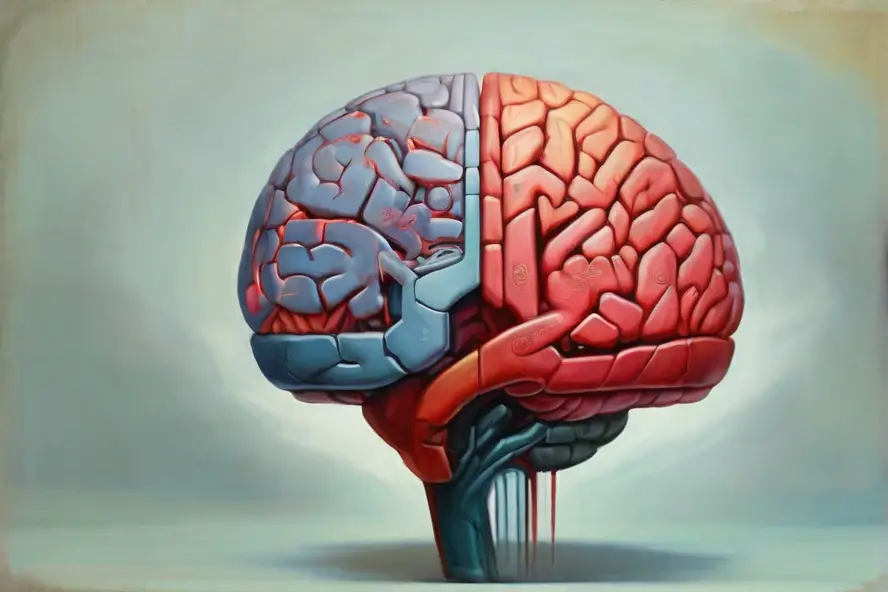
The human brain is a fascinating and complex organ that plays a crucial role in our daily lives.
Two important parts of the brain are the cerebral cortex and the cerebrum.
While these terms are often used interchangeably, they refer to distinct structures with unique functions.
In this article, we will explore the differences between the cerebral cortex and the cerebrum, their locations, structures, and functions.
What is Cerebral Cortex?
Location
The cerebral cortex is the outer layer of the brain, acting as the brain’s command center and covering the cerebrum like a protective shell.
Its distinct grayish appearance earns it the nickname “gray matter,” and it measures approximately 2-4 millimeters in thickness.
- Read also: Adrenal Cortex vs. Medulla Explained
- Read also: Understanding Spastic vs. Dyskinetic Cerebral Palsy
Structure
Structurally, the cerebral cortex is organized into four main lobes: frontal, parietal, temporal, and occipital.
Each lobe specializes in specific functions that contribute to our overall cognitive abilities.
Let’s take a closer look at these lobes and their associated roles:
- Frontal Lobe: Positioned at the front of the brain, this lobe is involved in critical functions like motor control, problem-solving, spontaneity, memory, language, initiation, judgment, impulse control, and social and sexual behavior.
- Parietal Lobe: Located towards the top and back, the parietal lobe is responsible for processing sensory information it receives from the outside world, mainly relating to spatial sense and navigation (proprioception), the main sensory receptive area for the sense of touch.
- Temporal Lobe: Situated on the sides of the brain, the temporal lobe is primarily associated with auditory processing and is also involved in the processing of semantics in both speech and vision. It houses the hippocampus and is critical for the formation of new memories.
- Occipital Lobe: Positioned at the back of the brain, the occipital lobe is mainly responsible for visual processing. It interprets and makes sense of the visual information received from the eyes.
Functions
The cerebral cortex plays a critical role in higher cognitive functions, including:
- Thought: The cortex is where your thoughts form. It’s where you ponder ideas, solve problems, and imagine possibilities.
- Memory: Whether it’s remembering what you had for breakfast or recalling childhood events, your memories are stored and retrieved within the cerebral cortex.
- Attention: When you focus your mind on something, whether it’s reading a book or listening to a friend, your cerebral cortex is hard at work, helping you pay attention.
- Perception: The cortex helps you make sense of the world around you by processing sensory information from your environment.
- Awareness: Your awareness of yourself and your surroundings stems from the cerebral cortex. It gives you a sense of being present in the here and now.
- Language: From understanding words to forming sentences, language skills rely heavily on the cerebral cortex, particularly the areas within the temporal and frontal lobes.

What is Cerebrum?
Location
Nestled at the topmost region of the brain, the cerebrum commands attention with its imposing size.
It is strategically positioned, overseeing and coordinating a vast array of activities that contribute to our daily experiences and interactions with the world.
It is divided into two hemispheres: the left and right hemispheres.
Structure
Delving into the cerebrum’s inner architecture, we encounter a trio of essential components that work in harmony to facilitate its multifaceted functions.
- Cerebral Cortex: This is the outermost layer, often referred to as the “gray matter” due to its distinct color. It houses the cerebral cortex, responsible for higher cognitive functions.
- Underlying white matter: Beneath the cerebral cortex lies a network of white matter, consisting of nerve fibers that facilitate communication between different regions of the brain.
- Deep brain structures: Within the depths of the cerebrum, we find integral structures like the thalamus and hypothalamus.
Functions
The cerebrum, with its grandeur and complexity, orchestrates a symphony of functions crucial to our daily existence.
- Voluntary movement: It serves as the command center for voluntary movements, allowing us to navigate the world with purpose and precision.
- Sensory perception: The cerebrum processes sensory information from the environment, interpreting signals from our senses and shaping our perception of the world.
- Learning and reasoning: At the heart of intellectual prowess, the cerebrum is the epicenter for learning, reasoning, and problem-solving. It’s the hub for cognitive processes that elevate us to higher levels of understanding.
- Emotion: The cerebrum plays a pivotal role in the realm of emotions, influencing our feelings and responses to the world around us. It adds depth and nuance to our human experience.
Key Differences: Cerebral Cortex vs. Cerebrum

To better understand the distinctions between the cerebral cortex and the cerebrum, let’s summarize their differences in the following table:
| Aspect | Cerebral Cortex | Cerebrum |
| Location | The outer layer covering the cerebrum |
The largest part of the brain, the topmost region
|
| Structure | Divided into four lobes |
Consists of the cerebral cortex and other structures
|
| Functions | Higher cognitive functions |
Wide range of functions, including voluntary movement, sensory perception, learning, reasoning, and emoti
|
How Do The Cerebral Cortex and Cerebrum Work Together?
The dynamic collaboration between the cerebral cortex and cerebrum orchestrates a symphony of functions vital to our daily experiences.
Sensory integration
The cerebrum acts as a central hub for sensory information, receiving input from various pathways.
This information is then processed and synthesized by the cerebral cortex, creating a cohesive and unified perception of the world around us.
It’s like a master conductor harmonizing the diverse sensory inputs into a meaningful symphony.
Motor control
When it comes to movement, the cortex takes the lead.
It not only plans and initiates movements but also communicates these instructions to the cerebrum.
The cerebrum, in turn, relays these signals through the spinal cord to our muscles, orchestrating the precise execution of actions.
It’s a seamless choreography, with the cortex as the choreographer and the cerebrum executing the well-rehearsed dance.
Cognitive functions
The real magic happens in the realm of cognitive functions.
Complex processes like thought, language, memory, and emotions rely on the intricate interplay between the cerebral cortex and deeper brain structures within the cerebrum.
Think of it as a sophisticated conversation between different sections of the brain, each contributing its unique perspective to create the rich tapestry of human cognition.

- Read also: Frontal Lobe Exercises: Unlocking the Power of Cognitive Enhancement
- Read also: 10 Mind-Blowing Types of Brain Imaging Techniques
Conclusion
The human brain comprises two interconnected yet distinct components: the cerebral cortex and the cerebrum.
The cerebral cortex, residing as the outer layer, takes charge of higher cognitive functions.
In contrast, the cerebrum encompasses the entire brain’s largest part, hosting not only the cerebral cortex but also other vital structures.
To comprehend the intricacies of the human mind, it’s imperative to grasp the roles and disparities between these two brain regions.
FAQs
No, they are not. The cerebral cortex is the outer layer of the brain, while the cerebrum is the largest part of the brain, housing the cerebral cortex and other structures.
The cerebral cortex is involved in various higher cognitive functions, including thought, memory, attention, perception, awareness, and language.
Understanding these differences is essential for gaining insights into the complexities of the human brain and its various functions.


